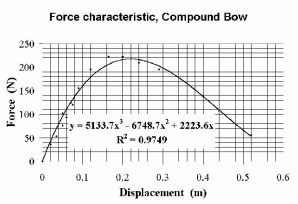http://www.medievalwarfare.info/pics/bow.jpg

What is a Bow & Draw weight?
The bow is a very powerful two-arm string machine used for archery. The bow stores mechanical potential energy when it's pulled back. Each bow is distinct, including the draw weight put on the bow by the person. The draw weight is the amount of force on the bow that goes into the arrow, which can be known as the elastic potential energy.
General Physics Behind a Bow
There are many mechanics to a bow, but the main physics of it is the force and energy that is excreted into pulling it back and letting it go.
When you draw a bow, you don’t stretch the string, you change the shape of the bow, giving potential energy to the bow that acts as a spring.
Start with a simple assumption that all PE is converted to KE ½mv2 = ½ eFx
or solving v = (eFx/m)-2 where e is an efficiency term (medieval bows 0.9).
But this is an overestimate. Why? When the arrow leaves the bow, parts of the bow are moving, which means that they have KE. Modify the equation to:
½ mv2 + k ½ Mv2 = ½ eFx
Where M is the mass of the bow and k is a factor which represents the sum of the KE’s of the moving parts of the bow. (k for medieval bows range from 0.03 and 0.07).
Thus v = sqrt( eFx / (m + kM)).
Compound Bows
The more work you have to do to draw a bow, the more energy it can transfer to an arrow. Compound bows use pulleys to help people do more work on the bow with less physical effort. In addition, when fully drawn, a compound bow's pulleys often holds part or even most of the draw weight. This is known as let-off, and it allows a person to hold and aim a drawn bow without as much strain or fatigue.
The bow is a very powerful two-arm string machine used for archery. The bow stores mechanical potential energy when it's pulled back. Each bow is distinct, including the draw weight put on the bow by the person. The draw weight is the amount of force on the bow that goes into the arrow, which can be known as the elastic potential energy.
General Physics Behind a Bow
There are many mechanics to a bow, but the main physics of it is the force and energy that is excreted into pulling it back and letting it go.
When you draw a bow, you don’t stretch the string, you change the shape of the bow, giving potential energy to the bow that acts as a spring.
Start with a simple assumption that all PE is converted to KE ½mv2 = ½ eFx
or solving v = (eFx/m)-2 where e is an efficiency term (medieval bows 0.9).
But this is an overestimate. Why? When the arrow leaves the bow, parts of the bow are moving, which means that they have KE. Modify the equation to:
½ mv2 + k ½ Mv2 = ½ eFx
Where M is the mass of the bow and k is a factor which represents the sum of the KE’s of the moving parts of the bow. (k for medieval bows range from 0.03 and 0.07).
Thus v = sqrt( eFx / (m + kM)).
Compound Bows
The more work you have to do to draw a bow, the more energy it can transfer to an arrow. Compound bows use pulleys to help people do more work on the bow with less physical effort. In addition, when fully drawn, a compound bow's pulleys often holds part or even most of the draw weight. This is known as let-off, and it allows a person to hold and aim a drawn bow without as much strain or fatigue.
http://physics.mercer.edu/petepag/bowf2.jpg
